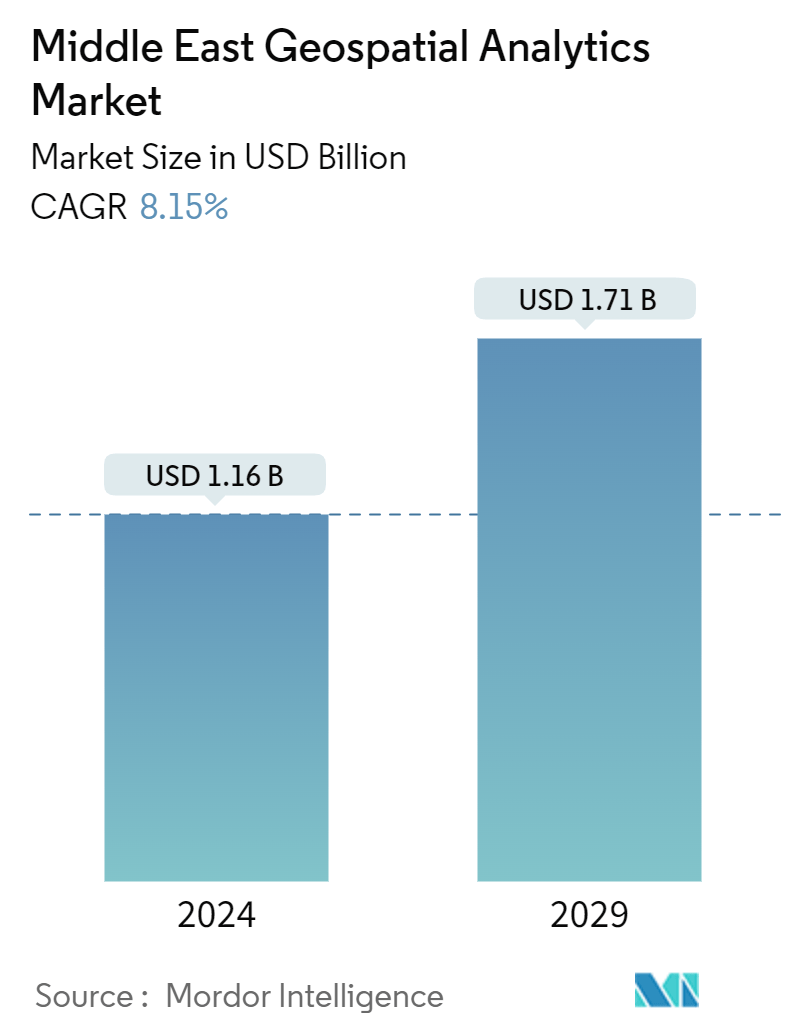Market Size of Middle East Geospatial Analytics Industry

| Study Period | 2019 - 2029 |
| Base Year For Estimation | 2023 |
| Market Size (2024) | USD 1.16 Billion |
| Market Size (2029) | USD 1.71 Billion |
| CAGR (2024 - 2029) | 8.15 % |
| Market Concentration | Medium |
Major Players
*Disclaimer: Major Players sorted in no particular order |
Middle East Geospatial Analytics Market Analysis
The Middle East Geospatial Analytics Market size is estimated at USD 1.16 billion in 2024, and is expected to reach USD 1.71 billion by 2029, growing at a CAGR of 8.15% during the forecast period (2024-2029).
Geospatial analysis refers to a broad range of activities that emphasize applying various techniques to data comprising geographical or space-related characteristics. Some of the key factors driving the development of the geospatial analytics market include the increasing use of GPS devices, technological advances in the field of GIS technology, recent trends in integration and convergence of geospatial technologies, the advent of new corporation models aimed at leveraging the demand for geospatial information, and increased application of geospatial analytics in city and town planning.
- Network analysis has gained prominence in today's cities, which are becoming increasingly congested. For instance, in the case of any emergency response system (ERS), the best route or shortest path analysis data using spatial data directly improves the fire emergency response, police station emergency response, healthcare emergency response system, etc. Google Maps extensively uses spatial data to provide multiple routes, the best routes, and real-time analysis to re-route if the user cannot follow the suggested path.
- Furthermore, network analysis is significant for utility companies operating in cities with complex network asset management problems. It helps companies efficiently design and model complex network infrastructures for supplying electrical, telecommunications, gas, and water to consumers using spatial data.
- The UAE Space Agency, the Israeli Ministry of Innovation, Science and Technology, and the Israel Space Agency are inviting universities and research institutes in the United Arab Emirates and Israel to submit joint research proposals based on data from the Israeli Vegetation and Environment Monitoring New Micro Satellite (VENS), which monitors the earth's environment and vegetation. The recommendations will be part of the Environment Monitoring Joint Research Project.
- This Earth observation program collects data using space-based remote sensing and contributes to necessary scientific research on our planet. The UAE and Israel Space Agency will contribute USD 200,000 to the selected research project. Initiatives like these would create an opportunity for the studied market to grow.
- In addition to this, with the advent of satellite remote sensing, global navigation satellite systems (GNSS), aerial surveys using photographic cameras, digital cameras, sensor networks, radar, and LiDAR, the volume of geospatial data has grown exponentially with data production.
- Big Data application workflow, thus, enables filtering, transformation, extraction, and other pre-processing operations on geospatial data, including raster imagery. High-volume, high-velocity data from multiple sources, such as sensors, satellites, mobile mapping, and location feeds from mobile devices, can be aggregated in the Big Data applications and processed to identify relevant high-value data.
- High costs and operational concerns, such as the limited presence of open standards and interoperability mechanisms and integration issues between ERM and GIS systems, hinder the geospatial analytics market's adoption rate. Although the overall costs of geospatial analysis solutions have decreased drastically since the turn of the decade, owing to the greater availability of open-source tools and plunging hardware costs, it remains a major concern for small and medium-scale companies. Generic location-based data is readily available over the Internet; however, it offers limited demographic insights and is not completely useful for making strategic decisions.
Middle East Geospatial Analytics Industry Segmentation
Geospatial analytics is acquiring, manipulating, and displaying imagery and data from the geographic information system (GIS), such as satellite photos and GPS data. The specific identifiers of a street address and a zip code are used in geospatial data analytics. They are used to create geographic models and data visualizations for more accurate trends modeling and forecasting.
The Middle East geospatial analytics market is segmented by type (surface analysis, network analysis, geovisualization), by end user vertical (agriculture, utility and communication, defence and intelligence, government, mining and natural resources, automotive and transportation, healthcare, real estate, and construction), by country (United Arab Emirates, Turkey, Saudi Arabia). The market sizes and forecasts regarding value (USD) for all the above segments are provided.
| By Type | |
| Surface Analysis | |
| Network Analysis | |
| Geovisualization |
| By End-user Vertical | |
| Agriculture | |
| Utility and Communication | |
| Defense and Intelligence | |
| Government | |
| Mining and Natural Resources | |
| Automotive and Transportation | |
| Healthcare | |
| Real Estate and Construction | |
| Other End-user Verticals |
| By Country | |
| United Arab Emirates | |
| Turkey | |
| Saudi Arabia |
Middle East Geospatial Analytics Market Size Summary
The Middle East Geospatial Analytics Market is poised for significant growth, driven by the increasing integration of geospatial technologies in various sectors. The market is experiencing a surge in demand due to advancements in GPS and GIS technologies, as well as the growing application of geospatial analytics in urban planning and smart city development. The proliferation of satellite remote sensing, GNSS, and aerial surveys has led to an exponential increase in geospatial data, which is being harnessed for diverse applications such as disaster mitigation, utility management, and ecological zoning. Collaborative initiatives, like those between the UAE and Israel, further underscore the region's commitment to leveraging geospatial data for environmental monitoring and research, creating ample opportunities for market expansion.
The market's growth is also supported by strategic partnerships and technological innovations among key players. Companies like Atkins, Autodesk, and Bentley Systems are investing in product developments and collaborations to enhance their market presence. Notable advancements include Microsoft's introduction of new geospatial analysis functions and the partnership between Autodesk and Esri, which integrates BIM and GIS data for improved infrastructure analysis. Additionally, the adoption of geospatial analytics in the utility and communication sectors, driven by initiatives like the UAE's Energy Policy 2050, highlights the market's potential. Despite challenges such as high costs and interoperability issues, the market is expected to thrive, supported by government policies and the increasing need for efficient resource management and urban planning solutions.
Middle East Geospatial Analytics Market Size - Table of Contents
-
1. MARKET INSIGHTS
-
1.1 Market Overview
-
1.2 Industry Attractiveness - Porter's Five Forces Analysis
-
1.2.1 Bargaining Power of Buyers
-
1.2.2 Bargaining Power of Suppliers
-
1.2.3 Threat of New Entrants
-
1.2.4 Threat of Substitutes
-
1.2.5 Intensity of Competitive Rivalry
-
-
1.3 Industry Value Chain Analysis
-
1.4 Assessment of the Impact of COVID-19 on the Market
-
-
2. MARKET SEGMENTATION
-
2.1 By Type
-
2.1.1 Surface Analysis
-
2.1.2 Network Analysis
-
2.1.3 Geovisualization
-
-
2.2 By End-user Vertical
-
2.2.1 Agriculture
-
2.2.2 Utility and Communication
-
2.2.3 Defense and Intelligence
-
2.2.4 Government
-
2.2.5 Mining and Natural Resources
-
2.2.6 Automotive and Transportation
-
2.2.7 Healthcare
-
2.2.8 Real Estate and Construction
-
2.2.9 Other End-user Verticals
-
-
2.3 By Country
-
2.3.1 United Arab Emirates
-
2.3.2 Turkey
-
2.3.3 Saudi Arabia
-
-
Middle East Geospatial Analytics Market Size FAQs
How big is the Middle East Geospatial Analytics Market?
The Middle East Geospatial Analytics Market size is expected to reach USD 1.16 billion in 2024 and grow at a CAGR of 8.15% to reach USD 1.71 billion by 2029.
What is the current Middle East Geospatial Analytics Market size?
In 2024, the Middle East Geospatial Analytics Market size is expected to reach USD 1.16 billion.

